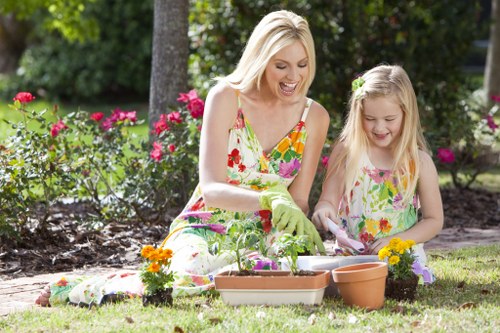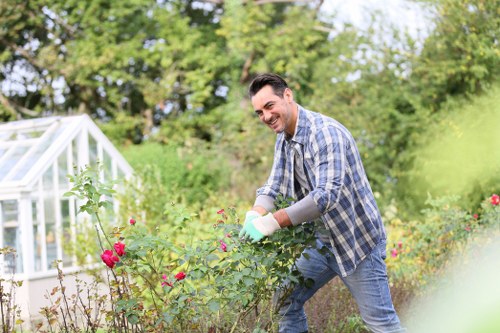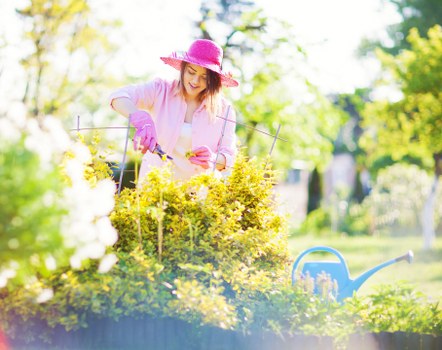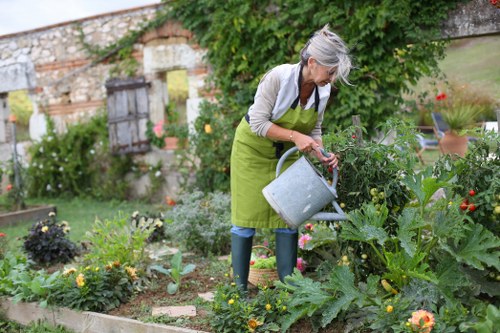Comprehensive Guide to Garden Maintenance in Thamesmead
Introduction to Garden Maintenance

Maintaining a beautiful garden in Thamesmead requires dedication, knowledge, and the right strategies. Whether you are a seasoned gardener or a novice, understanding the essential aspects of garden maintenance can transform your outdoor space into a vibrant and thriving environment.
Thamesmead’s unique climate and soil conditions present both challenges and opportunities for gardeners. With proper care, you can ensure that your garden flourishes throughout the year.
In this guide, we will explore the key elements of garden maintenance specific to Thamesmead, providing you with actionable tips and insights to keep your garden in top shape.
Understanding the Thamesmead Climate

Thamesmead experiences a temperate maritime climate, characterized by mild winters and cool summers. This climate influences the types of plants that thrive in the area and dictates the maintenance routines necessary to keep your garden healthy.
Key Climatic Factors:
- Temperature: Average temperatures range from 2°C in winter to 22°C in summer.
- Rainfall: Relatively high annual rainfall ensures that plants receive adequate moisture.
- Sunlight: Good sunlight exposure is essential for the growth of most garden plants.
Understanding these factors helps in selecting the right plants and scheduling maintenance tasks effectively.
Soil Preparation and Health

The foundation of any successful garden is healthy soil. Thamesmead’s soil can vary, but it is generally a mix of clay and sandy loam, which requires proper management to enhance fertility and drainage.
Soil Testing: Conducting a soil test helps determine pH levels and nutrient deficiencies. This information is crucial for selecting appropriate fertilizers and amendments.
Regularly adding organic matter, such as compost or well-rotted manure, improves soil structure and promotes beneficial microbial activity. Mulching also helps retain moisture and suppress weeds.
Choosing the Right Plants

Selecting plants that are well-suited to Thamesmead’s climate and soil conditions is essential for a thriving garden. Opt for native and resilient species that can withstand local weather patterns.
Consider the following factors when choosing plants:
- Sunlight Requirements: Ensure that plants receive adequate sunlight based on their specific needs.
- Water Needs: Group plants with similar watering requirements to optimize irrigation.
- Growth Habits: Consider the mature size and growth patterns to prevent overcrowding.
- Maintenance Levels: Choose plants that match your gardening expertise and the amount of time you can dedicate to maintenance.
Some recommended plants for Thamesmead gardens include lavender, rosemary, hydrangeas, and hardy perennials like hostas.
Regular Garden Maintenance Tasks

Consistent maintenance is key to a healthy garden. Here are the essential tasks you should incorporate into your gardening routine:
1. Watering
Proper watering ensures that plants receive the necessary moisture without becoming waterlogged. Early morning is the best time to water, reducing evaporation and promoting deep root growth.
Tips:
- Use drip irrigation or soaker hoses for efficient water distribution.
- Adjust watering schedules based on seasonal changes and rainfall.
- Avoid overhead watering to prevent fungal diseases.
2. Weeding
Removing weeds regularly prevents them from competing with your plants for nutrients and water. Mulching can help suppress weed growth effectively.
Techniques:
- Hand-pull weeds to avoid disturbing the soil structure.
- Use a hoe or other tools for larger areas.
- Apply a thick layer of mulch to create a barrier against weeds.
3. Pruning and Trimming
Pruning encourages healthy growth and maintains the desired shape of your plants. It also helps remove dead or diseased branches, promoting overall plant health.
Pruning Tips:
- Use sharp, clean tools to make precise cuts.
- Remove no more than 20% of the plant’s foliage at a time.
- Prune in the appropriate season for each plant type.
Pest and Disease Management

Protecting your garden from pests and diseases is crucial for maintaining plant health. Integrated Pest Management (IPM) strategies offer an eco-friendly approach to controlling garden issues.
Common Pests in Thamesmead:
- Aphids
- Snails and slugs
- Japanese beetles
- Leaf miners
To manage pests:
- Encourage beneficial insects like ladybugs and predatory beetles.
- Use barriers and traps for slugs and snails.
- Apply organic pesticides as a last resort.
Regular monitoring and early intervention can prevent minor issues from escalating into major problems.
Seasonal Garden Care

Each season brings its own set of maintenance tasks. Adapting your garden care routine to the changing seasons ensures year-round garden health.
Spring
Spring is the time for planting and preparing your garden for the growing season.
- **Plant new blooms** and perennials.
- **Clean up** garden beds and remove debris.
- **Apply fertilization** to boost growth.
Summer
Summer focuses on maintaining moisture levels and managing growth.
- **Water regularly** and deeply.
- **Prune** as needed to encourage air circulation.
- **Monitor for pests** and take action promptly.
Autumn
Autumn involves preparing the garden for winter dormancy.
- **Rake leaves** and clear fallen debris.
- **Plant bulbs** for spring flowers.
- **Apply mulch** to protect plant roots.
Winter
Winter is a period of minimal activity, focusing on protection and planning.
- **Protect sensitive plants** with covers or mulching.
- **Plan for next year’s garden** layout and plant selections.
- **Maintain tools** by cleaning and storing them properly.
Tools and Equipment for Garden Maintenance

Having the right tools can make garden maintenance more efficient and enjoyable. Essential garden tools include:
- **Pruning shears** for trimming and shaping plants.
- **Garden fork** for aerating soil.
- **Hose and watering tools** for efficient irrigation.
- **Weeding tools** to remove unwanted plants.
- **Gloves** to protect your hands while working.
Investing in high-quality tools ensures durability and effectiveness, making your gardening tasks easier.
Eco-Friendly Gardening Practices

Adopting eco-friendly practices not only benefits the environment but also enhances the sustainability of your garden. Here are some green gardening tips:
- Composting: Recycle organic waste into nutrient-rich compost for your garden.
- Rainwater Harvesting: Collect rainwater to use for irrigation, reducing water consumption.
- Native Plants: Choose native species that require less maintenance and are more resistant to local pests.
- Organic Fertilizers: Use natural fertilizers to promote healthy plant growth without harming the environment.
Implementing these practices contributes to a healthy ecosystem and a more resilient garden.
Landscaping and Design Tips

Thoughtful landscaping can enhance the beauty and functionality of your garden. Consider the following design tips:
Creating Focal Points
Establishing focal points, such as a garden bench, fountain, or specimen plant, draws attention and adds visual interest.
Design Ideas:
- **Ornamental trees** as central features.
- **Garden sculptures** or art installations.
- **Water features** like ponds or fountains.
Pathways and Access
Well-designed pathways facilitate easy movement through the garden and highlight key areas.
Pathway Materials:
- **Stone** or gravel for a natural look.
- **Brick** or paving slabs for durability.
- **Mulch** for informal pathways.
Plant Diversity
Incorporating a variety of plant species adds texture, color, and interest to your garden throughout the year.
Planting Tips:
- Mix perennials with annuals for continuous blooms.
- Use evergreen plants to maintain structure in winter.
- Incorporate plants with different foliage textures.
Hiring Professional Garden Maintenance Services

While DIY gardening can be rewarding, hiring professional garden maintenance services in Thamesmead offers several advantages:
- Expertise: Professionals have the knowledge and experience to handle various gardening tasks efficiently.
- Time-Saving: Outsourcing maintenance allows you to focus on other priorities.
- Quality Results: Professionals ensure that your garden is maintained to the highest standards.
When choosing a garden maintenance service, consider factors such as reputation, range of services, and pricing to find the best fit for your needs.
Benefits of Regular Garden Maintenance

Consistent garden maintenance offers numerous benefits, enhancing both the aesthetics and functionality of your outdoor space.
- Enhanced Curb Appeal: A well-maintained garden improves the overall appearance of your property.
- Increased Property Value: Beautiful gardens can boost property values and attract potential buyers.
- Healthier Plants: Regular care prevents diseases and promotes robust plant growth.
- Environmental Impact: Gardens contribute to air purification, carbon sequestration, and biodiversity.
Investing time and resources into garden maintenance yields long-term rewards for both you and the environment.
Common Garden Maintenance Mistakes to Avoid

Even experienced gardeners can fall into common pitfalls that hinder garden health. Here are some mistakes to avoid:
- Overwatering: Excessive watering can lead to root rot and other plant diseases.
- Underestimating Sunlight Needs: Planting sun-loving plants in shady areas can stunt their growth.
- Ignoring Soil Health: Neglecting soil fertility can result in nutrient deficiencies and poor plant performance.
- Poor Pruning Techniques: Incorrect pruning can damage plants and inhibit growth.
- Inadequate Pest Control: Failing to manage pests promptly can lead to significant plant damage.
Being aware of these mistakes allows you to take proactive measures to maintain a healthy garden.
Innovative Gardening Trends in Thamesmead

Staying updated with the latest gardening trends can inspire new ideas and improve your garden maintenance practices. Popular trends in Thamesmead include:
- Vertical Gardening: Maximizing space by growing plants vertically using trellises, wall planters, or hanging baskets.
- Sustainable Gardening: Emphasizing eco-friendly practices such as composting, rainwater harvesting, and using organic fertilizers.
- Smart Gardening: Utilizing technology like automated irrigation systems and gardening apps to enhance maintenance efficiency.
- Native Plant Landscaping: Focusing on native species that support local wildlife and require less maintenance.
- Edible Gardens: Integrating fruit, vegetable, and herb plants into ornamental gardens for both beauty and functionality.
Incorporating these trends can modernize your garden and align it with contemporary sustainability goals.
DIY Garden Maintenance Tips

For those who prefer a hands-on approach, here are some DIY garden maintenance tips to keep your Thamesmead garden thriving:
Create a Maintenance Schedule
Organize your tasks by creating a seasonal maintenance schedule. This ensures that essential tasks are not overlooked.
Sample Schedule:
- Spring: Planting, pruning, fertilizing.
- Summer: Watering, weeding, pest control.
- Autumn: Leaf removal, mulching, bulb planting.
- Winter: Tool maintenance, garden planning.
Use Natural Remedies
Opt for natural pest and disease control methods to maintain an eco-friendly garden. For example, neem oil can be used to manage insect pests, and baking soda solutions help prevent fungal diseases.
Compost Your Waste
Creating your own compost recycles garden and kitchen waste into valuable fertilizer. A DIY compost bin is easy to set up and significantly benefits soil health.
Implement Efficient Watering Practices
Reduce water usage by implementing efficient watering practices such as drip irrigation, rain barrels, and mulching. These methods conserve water and promote sustainable gardening.
Regularly Inspect Plants
Frequent inspections help detect early signs of pests or diseases, allowing for timely intervention and preventing widespread issues.
Enhancing Garden Aesthetics

Aesthetics play a significant role in garden maintenance, contributing to the overall beauty and enjoyment of your outdoor space.
Color Coordination
Plan your plantings around a color scheme to create a harmonious look. Complementary colors or a monochromatic palette can make your garden visually appealing.
Color Scheme Ideas:
- **Bold and Bright:** Use vibrant colors like reds, yellows, and oranges for a lively garden.
- **Pastel Palette:** Soft colors like pinks, blues, and lavenders offer a serene atmosphere.
- **Monochromatic:** Different shades of a single color provide a sophisticated look.
Texture and Form
Incorporate plants with varying textures and forms to add depth and interest. Mix leafy plants with those that have interesting stems, flowers, or foliage patterns.
Lighting
Outdoor lighting enhances the garden’s beauty at night and improves safety. Use solar lights, string lights, or spotlights to highlight key features and pathways.
Garden Art and Decor
Integrate garden art and decorative elements such as sculptures, birdbaths, or decorative pots to personalize your garden and add unique touches.
Sustainable Garden Practices

Sustainability is increasingly important in garden maintenance. Implementing sustainable practices contributes to environmental conservation and creates a healthier garden ecosystem.
- Reduce Chemical Use: Minimize the use of synthetic pesticides and fertilizers by opting for organic alternatives.
- Conserve Water: Use water-efficient irrigation systems and drought-resistant plants to reduce water consumption.
- Promote Biodiversity: Encourage a diverse range of plants and wildlife to create a balanced garden ecosystem.
- Recycling: Reuse garden materials and recycle organic waste through composting.
Adopting these practices ensures that your garden remains healthy and environmentally friendly.
Composting
Composting transforms kitchen scraps and garden waste into nutrient-rich soil amendments, reducing landfill waste and improving soil health.
How to Compost:
- **Choose a Compost Bin:** Select a bin that suits your space and needs.
- **Add Organic Materials:** Include green (nitrogen-rich) and brown (carbon-rich) materials.
- **Maintain the Pile:** Keep the compost moist and turn it regularly to aerate.
- **Harvest Compost:** After several months, use the finished compost to enrich your garden soil.
Rainwater Harvesting
Catching and storing rainwater is an effective way to reduce water usage in your garden. Use rain barrels or other collection systems to gather water during rainfall, which can then be used for irrigation.
Mulching
Applying mulch around plants conserves moisture, suppresses weeds, and adds organic matter to the soil as it decomposes.
Types of Mulch:
- **Organic Mulch:** Includes wood chips, straw, and compost.
- **Inorganic Mulch:** Consists of gravel, rubber, or landscape fabric.
Community and Garden Groups in Thamesmead

Joining local garden groups and communities in Thamesmead provides opportunities for learning, sharing resources, and receiving support in garden maintenance.
- Local Gardening Clubs: Engage with fellow gardeners to exchange tips and organize community projects.
- Workshops and Seminars: Attend educational events to enhance your gardening knowledge and skills.
- Community Gardens: Participate in shared gardening spaces to cultivate a sense of community and collective responsibility.
Being part of a gardening community fosters collaboration and can make garden maintenance more enjoyable and effective.
Final Thoughts on Garden Maintenance in Thamesmead

Maintaining a garden in Thamesmead is a rewarding endeavor that enhances your living space and contributes to environmental well-being. By understanding the local climate, preparing the soil, selecting suitable plants, and adhering to regular maintenance practices, you can cultivate a thriving and beautiful garden.
Whether you choose to manage your garden yourself or enlist professional services, the key to success lies in consistency, knowledge, and a passion for gardening.
Ready to transform your Thamesmead garden? Contact us today to book your garden maintenance service and take the first step towards a stunning outdoor sanctuary.